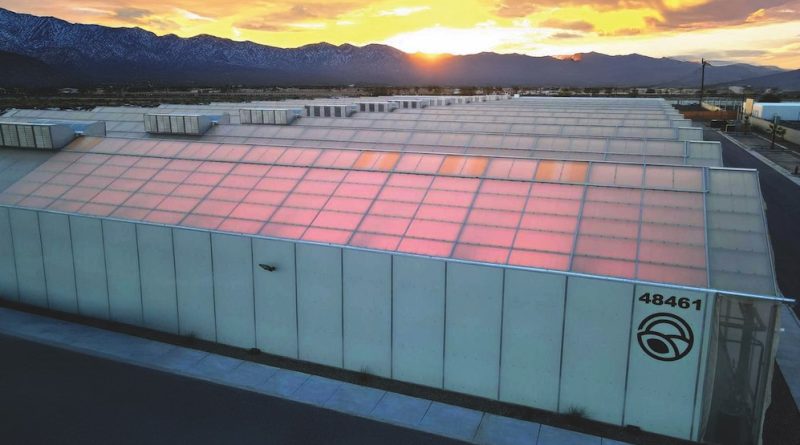Coachella’s Next Big Thing Is Here
From toxifillers.com with love
To many people, the southern California desert may not seem like the best place to build a world-class cannabis cultivation facility. But for Green Horizons, the company’s location in the city of Coachella is an integral part of its plan for success in the Golden State’s competitive regulated cannabis market. Combining the experience of cannabis executive Carlos “Los” Arias, the marketing prowess of fashion icon Tommy Hilfiger and the real estate and construction experience of developer Michael Meade, the company has targeted 2025 as a pivotal time in its growth and evolution.
Green Horizons’ CEO Arias is a lawyer by training and one of the many pioneers of regulated cannabis in the US. As one of the principals at Colorado’s River Rock, he helped create cannabis cultivation and retail infrastructure for the greater Denver area following legalization in the state in 2012.
Arias then set his eyes on California, where he established an 18,000-square-foot indoor cannabis cultivation facility near Palm Springs in Cathedral City. Mutual connections introduced him to Meade, who had a vision to make the nearby city of Coachella California’s “Napa Valley of the South,” only with weed instead of wine.

The Coachella Valley has an agricultural heritage going back more than a century, and Meade believed that history could be reinvigorated with cannabis. Working with city leaders, he helped establish the city of Coachella’s cannabis cultivation zone and improvements to make it operational, such as power and sewer lines. Meade also secured a two percent tax rate for his planned operation for spearheading the development of a local cannabis industry, giving Green Horizons a significant competitive edge in California’s regulated market. With the green light for development in Coachella, Meade partnered with Arias to create a premier cannabis cultivation facility. Green Horizons’ mixed-light cultivation facility couples the reliable desert sun with modern lighting equipment, reportedly making it more efficient and sustainable than traditional indoor growing operations.
Arias says that Green Horizons is “unabashed about the power of the sun,” noting that a common misconception holds that cannabis produced in mixed-light facilities is inferior to weed grown in more energy-intensive indoor facilities. “We diametrically disagree with that, and we want to put forth a path toward creating something that’s more friendly for the Earth,” Arias says.

With the sun helping to provide the light for Green Horizons’ cannabis plants, the company uses less electricity than a traditional indoor cultivation operation, making the facility more sustainable. The cultivation operation also doesn’t use air conditioning, relying instead on evaporative cooling, a method that takes far less energy to protect the plants from the desert heat. Further savings compared to competitors come from Coachella’s connection to the Imperial Irrigation District’s power grid, which provides electricity at rates that Arias says are 30-40 percent lower than Southern California Edison, the source used by much of the region’s cannabis operators.
The Green Horizons facility has a reliable source of water from the Colorado River via infrastructure built to support the Coachella Valley agriculture industry. A well on the site also gives the company flexibility in its source of irrigation water.

Construction of the first 100,000 square feet of the projected 1 million-square-foot facility began in 2022 and was completed two years later with a ribbon-cutting ceremony in May 2024. Since then, cultivation operations have begun, with the facility’s first harvest arriving last November. The first four months of harvests yielded about 3,000 pounds, which was sold in bulk or through white label operations to California licensed cannabis brands. Arias says the facility is on pace to triple production by summer 2025, with the first phase of the facility projected to produce about 35,000 pounds of top-quality cannabis per year.

The next phase of Green Horizons’ plans includes developing the company’s first brand, SOL (“sun” in Spanish). Arias says it’s an “homage to the Coachella Valley roots.” But with Meade’s expertise lying primarily in real estate development and Arias specializing in cannabis cultivation, they decided to seek expert help with brand development.
“We know how to build buildings,” Arias says. “That’s what my partner, Michael Meade knows how to do very well. I’ve cut my teeth in cultivation and regulated markets, going back to 2012 in Colorado. What we needed was the brand building portion.”
For that expertise, the Green Horizons executives looked to entrepreneur and fashion mogul Tommy Hilfiger, who became a founding partner and investor in the enterprise. Arias says he met Ally Hilfiger, Tommy’s daughter, through the plant medicines community. Both Meade and Arias are cancer survivors, and Ally, who was diagnosed with Lyme disease at 19 after enduring symptoms for more than a decade, says that cannabis changed her life. After swapping stories with one other, Arias says he and Ally quickly became friends.
One of Tommy Hilfiger’s initial goals with Green Horizons is bringing SOL to market. The company also bought an interest in Boast, an apparel and lifestyle brand now co-owned by Hilfiger and Green Horizons. Starting with these two brands, Hilfiger will help chart a path to production of Green Horizons’ own consumer packaged goods. Arias notes that “obviously, something like that just doesn’t happen overnight. But with somebody like that on the ticket, we feel comfortable about doing that a little bit further down the road.”
Ally is also intimately involved, serving as Green Horizons’ chief advocacy officer. In this role, she says she plans to work toward the de-stigmatization of cannabis and meaningful policy reform at the federal level.

